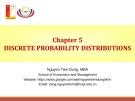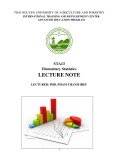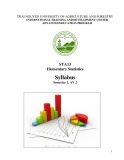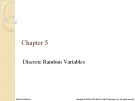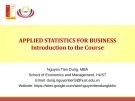
Discrete probability distribution
-
Lectures "Applied statistics for business - Chapter 5: Discrete probability distributions" provides students with the knowledge: Random variables, developing discrete probability distributions, expected value and variance, expected value and variance financial portfolios,... Invite you to refer to the disclosures.
 34p
34p  doinhugiobay_13
doinhugiobay_13
 26-01-2016
26-01-2016
 55
55
 3
3
 Download
Download
-
Lecture "Probability & statistics - Chapter 5: Discrete probability" has contents: Random variable, probability distribution, expected value, variance – standard deviation, bivariate probability, binomial distribution.
 21p
21p  abcxyz123_07
abcxyz123_07
 19-03-2020
19-03-2020
 37
37
 2
2
 Download
Download
-
After studying this chapter you will be able to: Introduction to statistics, methods for describing data, probability, discrete probability distributions, the normal probability distribution, confidence interval, hypothesis testing.
 96p
96p  koxih_kothogmih1
koxih_kothogmih1
 03-08-2020
03-08-2020
 22
22
 2
2
 Download
Download
-
The object (for students) in this course is: To learn how to interpret statistical summaries appearing in journals, newspaper reports, internet, television, etc; to learn about the concepts of probability and probabilistic reasoning; to understand variability and analyze sampling distribution; to learn how to interpret and analyze data arising in your own work (course work or research).
 6p
6p  koxih_kothogmih1
koxih_kothogmih1
 03-08-2020
03-08-2020
 28
28
 2
2
 Download
Download
-
Chapter 5 - Discrete random variables. After mastering the material in this chapter, you will be able to: Explain the difference between a discrete random variable and a continuous random variable, find a discrete probability distribution and compute its mean and standard deviation, use the binomial distribution to compute probabilities,...
 12p
12p  whocare_b
whocare_b
 05-09-2016
05-09-2016
 71
71
 3
3
 Download
Download
-
The lecture "Applied statistics for business" provides students with the knowledge: Introduction to the Course, Course Materials, requirements for Students, Main Contents. Invite you to refer to the disclosures.
 8p
8p  doinhugiobay_13
doinhugiobay_13
 26-01-2016
26-01-2016
 61
61
 2
2
 Download
Download
-
Let A be an n × n matrix, whose entries are independent copies of a centered random variable satisfying the subgaussian tail estimate. We prove that the operator norm of A−1 does not exceed Cn3/2 with probability close to 1. 1. Introduction Let A be an n × n matrix, whose entries are independent, identically distributed random variables. The spectral properties of such matrices, in particular invertibility, have been extensively studied (see, e.g. [M] and the survey [DS]).
 28p
28p  dontetvui
dontetvui
 17-01-2013
17-01-2013
 54
54
 8
8
 Download
Download
CHỦ ĐỀ BẠN MUỐN TÌM









